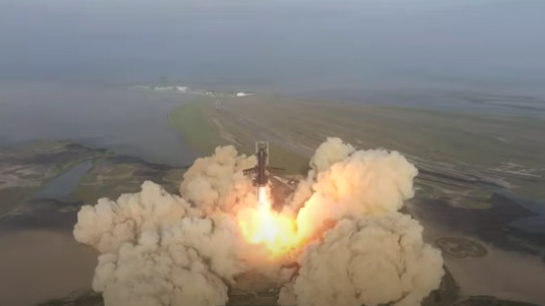The rocket took off – but only briefly
This Thursday, the aerospace company SpaceX tried for the second time to send its giant Starship rocket on a test flight. The first attempt on Monday could not take place because of a frozen valve. This time the take-off worked, but a short time later that was it with the scheduled procedure.
After all, you have “learned a lot for the next start,” says SpaceX boss Elon Musk via Twitter.
The test run at the SpaceX test site in Boca Chica, Texas was planned as follows: 170 seconds after the world’s largest lifted off rocket Should the first stage of the rocket, dubbed the Super Heavy, separate from the spacecraft and sink in the Gulf of Mexico? The Starship rocket itself would then have flown further and once around the earth before finally landing in the sea off Hawaii after an hour and a half.
In fact, the Starship rocket took off vertically into the sky just a few minutes late to thunderous applause. More than 1.5 million people watched the test flight on YouTube. However, the separation of the “Super Heavy” rocket stage failed and the rocket experienced a – quote SpaceX – “rapid unplanned disassembly”: It burst into flames.
The test flight is still a success for SpaceX: Everything after take-off was “the decoration on the cake”, according to a moderator in the live stream. The flight data will now be evaluated, learned from it and used to prepare for the next test flight, the company said on Twitter. Company boss Elon Musk also spoke up there – and congratulated the team on the spectacular rocket launch.
Before the first flight attempt, which failed on Monday, Musk had commented quite vaguely: “Success possible, excitement guaranteed”.
The private space company’s two-stage rocket is around 120 meters tall, making it the largest ever built. For example, the Saturn V rocket that NASA used to fly to the moon is a full ten meters smaller.
The first stage, fueled with oxygen and methane, is equipped with 33 rocket engines. The engines should be reused up to 1,000 times.
In the actual Starship, six engines of the same type are used. According to Elon Musk, it should be possible to transport 100 tons of cargo to Mars or to the surface of a Jovian moon.
Editor’s Recommendations
Another novelty of the Starship rocket: unlike NASA’s rockets, which head directly for their target, they can be refueled in orbit, giving them a particularly high payload. So in the future it could be possible to send an entire fleet of Mars rovers into space or, alternatively, to fly 100 people to the moon, for example.
The test flight is particularly exciting for two reasons: For the first time, both rocket stages will be used simultaneously. And it’s the first flight to make it into Earth orbit.
In the future, the two rocket stages will no longer land in the water, but will return to the launch pad. The Starship could therefore be used again and again and make flights into space comparatively cheap.



